Papers by Hassan Bazazzadeh

Industrial heritage has become a very matter of debate among experts as the most significant remi... more Industrial heritage has become a very matter of debate among experts as the most significant reminder of the industrial era, it also is of great examples of 20th-century heritage. Nowadays, industrial heritage sites are suffering from intense physical conditions and are being intruded by massive economic projects since they are located in favorable places of towns and possess vast spaces. Conservation methods have mostly been limited to the surroundings of industrial heritage sites and have not considered the extended areas connected to the site. The resolutions should be sought throughout these questions: How do outstanding values of an industrial heritage site affect its buffer zone mapping? Or what should a buffer zone map encompass to protect specific values of an industrial heritage site? During this research ample of evidence is seen which firstly depicts the appreciation of industrial heritage and the tendency to conserve them among the host countries. The main result concluded is a guideline based on the similarities and differences between various types of industrial heritage and their impacts on determining boundaries and zones. In case of increasing the number of case studies, the results of this paper can aid in charge organizations to take more effective measure in developing plans to determine boundaries and zones for different types of industrial heritage sites. The data gathered for this paper was collected through library resources about industrial heritage and basically from academic and universal management manuals of buffer zones. The information chiefly is adopted from registration files received by the world heritage committee of UNESCO. The method of this research is case study research and the method for analysis is descriptive-analytical
Energies, 2021
This article is an open access article distributed under the terms and conditions of the Creative... more This article is an open access article distributed under the terms and conditions of the Creative Commons Attribution (CC BY

In recent years, the significance of industrial heritage has seemed to become a growing trend in ... more In recent years, the significance of industrial heritage has seemed to become a growing trend in the international heritage studies. Concerning their attributed values, and the crucial needs for urban development, this branch of cultural heritage has been considered the important grid of cities. This has caused a great acceptance of adaptive reuse practices especially among developing countries which is a smart response to an ongoing debate to reach sustainable development. The flexibility of these buildings and sites seems an important criterion, which can be improved through adaptive reuse practice. Therefore, this research aims to introduce the concept of flexibility in industrial heritage sites, evaluate its criteria among adaptive reuse practice, and make a comprehensive flexibility model for it. Indeed, the final goal is to determine the condition that based on the flexibility model, the adaptive reuse practice would be a proper way of encountering these sites. A historical-in...
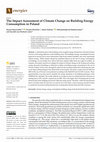
Energies, 2021
A substantial share of the building sector in global energy demand has attracted scholars to focu... more A substantial share of the building sector in global energy demand has attracted scholars to focus on the energy efficiency of the building sector. The building’s energy consumption has been projected to increase due to mass urbanization, high living comfort standards, and, more importantly, climate change. While climate change has potential impacts on the rate of energy consumption in buildings, several studies have shown that these impacts differ from one region to another. In response, this paper aimed to investigate the impact of climate change on the heating and cooling energy demands of buildings as influential variables in building energy consumption in the city of Poznan, Poland. In this sense, through the statistical downscaling method and considering the most recent Typical Meteorological Year (2004–2018) as the baseline, the future weather data for 2050 and 2080 of the city of Poznan were produced according to the HadCM3 and A2 GHG scenario. These generated files were the...
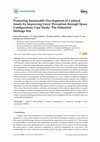
Sustainability, 2020
The role of the cultural assets as one of the pillars of sustainable development is undeniably of... more The role of the cultural assets as one of the pillars of sustainable development is undeniably of great significance in the cultural sustainability of cities. Indeed, the way users understand and interpret cultural heritage sites would be highly critical to managing cultural organizations properly. It means by improving users’ perception of these sites, it can expect a fair distribution of comprehensive awareness among generations about the values of cultural assets. Past studies in spatial psychology have demonstrated that environmental properties can positively Influence human emotions. On the other hand, using computational–mathematical methods used to examine spatio-visual properties have rarely been compared to human perceptions. This paper examines the impact of spatio-visual properties on human perception as a clever cultural management strategy to promote cultural sustainability. It is discussed how environmental features in general, and visibility in particular, can shape t...
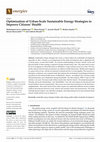
Energies, 2023
Sustainable energy strategies have been a critical subject for sustainable development, especiall... more Sustainable energy strategies have been a critical subject for sustainable development, especially in cities. Citizens, as an integral part of the urban environment, play a significant role in urban spaces, as does their health. An accurate understanding of citizens’ mental, social, and physical health in urban settings is required to design and plan better cities. This study aims to assess the level of alignment with health factors in Mahabad, a major medium-sized city in Iran. Previous studies indicate that the built environment can influence health dimensions. Health factors depend to a great extent on how well the environment is formed and how it is put together. This research is a descriptive, analytical, cross-sectional study that analyzes the environment’s psychological elements and physical and mental health factors of Mahabad’s citizens. According to the Cochran model, 384 questionnaires were distributed among households. For data analysis, SPSS 12 and Arc GIS software were used. The main results of this research show that five factors, “Environmental quality”, “Identity and social relationships”, and “Readability”, have the most impact on the physical and mental health of citizens (respondents). These issues are much more pronounced in the downtown neighborhoods. This study showed that urban experts can understand different levels of public health by knowing the historical, social, cultural, and economic factors and characteristics. The result will help decision makers, city authorities, designers, and urban planners to be more informed about citizens’ health and the ways to improve it.
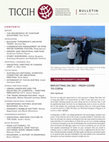
TICCIH Bulletin, 2022
The construction of railways has been one of the symbols of advanced technology and modernity in ... more The construction of railways has been one of the symbols of advanced technology and modernity in various societies and is known as a means of expanding and transferring goods, men, and their ideas. During the political-economic circumstances of the second half of the 19th century, the first rail line of Iran was built under the Qajar rule. This was an 8 km railway to connect Tehran to Rey with some small wagons, most local people tended to call it Mashin-Doodi, which translates as Smokey Machine. The railway then appeared in southwest Iran as a means of transport for the oil industry which was booming after oil discoveries in Khuzestan. The intercity railway started to operate in 1923 and was 57 km long, connecting Masjed-i-Soleyman to Dar-i-Kahzineh. It was established for exploitative purposes of foreign states resulting in a few small-scale and temporary projects, but the idea of constructing and expanding rail lines based on national investments finally materialized with the first national railroad.
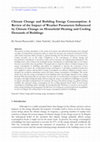
European Journal of Sustainable Development
The growth of urban population as the result of economic and industrial development has changed o... more The growth of urban population as the result of economic and industrial development has changed our place of living from a prosperous place to where the resources are carelessly consumed. On the other hand, long-term climate change, i.e. global warming, has had adverse impact on our resources. Certain resources are on the verge of depletion as the consequence of climate change and inconsiderate consumption of resources, unless serious measures are implemented immediately. The building sector, whose share in the municipal energy consumption is considerably high, is a key player that may successfully solve the problem. This paper aims to study the effects of climate change on the energy consumption of buildings and analyze its magnitude to increase the awareness of how construction can reduce the overall global energy consumption. A descriptive-analytical method has been applied to analyze valid models of energy consumption according to different scenarios and to interpret the conditi...
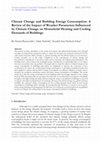
European Journal of Sustainable Development, 2021
The growth of urban population as the result of economic and industrial development has changed o... more The growth of urban population as the result of economic and industrial development has changed our place of living from a prosperous place to where the resources are carelessly consumed. On the other hand, long-term climate change, i.e. global warming, has had adverse impact on our resources. Certain resources are on the verge of depletion as the consequence of climate change and inconsiderate consumption of resources, unless serious measures are implemented immediately. The building sector, whose share in the municipal energy consumption is considerably high, is a key player that may successfully solve the problem. This paper aims to study the effects of climate change on the energy consumption of buildings and analyze its magnitude to increase the awareness of how construction can reduce the overall global energy consumption. A descriptive-analytical method has been applied to analyze valid models of energy consumption according to different scenarios and to interpret the conditi...
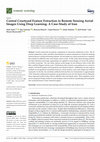
Remote Sensing
Central courtyards are primary components of vernacular architecture in Iran. The directions, dim... more Central courtyards are primary components of vernacular architecture in Iran. The directions, dimensions, ratios, and other characteristics of central courtyards are critical for studying historical passive cooling and heating solutions. Several studies on central courtyards have compared their features in different cities and climatic zones in Iran. In this study, deep learning methods for object detection and image segmentation are applied to aerial images, to extract the features of central courtyards. The case study explores aerial images of nine historical cities in Bsk, Bsh, Bwk, and Bwh Köppen climate zones. Furthermore, these features were gathered in an extensive dataset, with 26,437 samples and 76 geometric and climactic features. Additionally, the data analysis methods reveal significant correlations between various features, such as the length and width of courtyards. In all cities, the correlation coefficient between these two characteristics is approximately +0.88. Num...
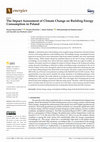
Energies, 2021
A substantial share of the building sector in global energy demand has attracted scholars to focu... more A substantial share of the building sector in global energy demand has attracted scholars to focus on the energy efficiency of the building sector. The building’s energy consumption has been projected to increase due to mass urbanization, high living comfort standards, and, more importantly, climate change. While climate change has potential impacts on the rate of energy consumption in buildings, several studies have shown that these impacts differ from one region to another. In
response, this paper aimed to investigate the impact of climate change on the heating and cooling energy demands of buildings as influential variables in building energy consumption in the city of Poznan, Poland. In this sense, through the statistical downscaling method and considering the most recent Typical Meteorological Year (2004–2018) as the baseline, the future weather data for 2050 and 2080 of the city of Poznan were produced according to the HadCM3 and A2 GHG scenario. These generated files were then used to simulate the energy demands in 16 building prototypes of the ASHRAE 90.1 standard. The results indicate an average increase in cooling load and a decrease in heating load at 135% and 40%, respectively, by 2080. Due to the higher share of heating load, the total thermal load of the buildings decreased within the study period. Therefore, while the total thermal load is currently under the decrease, to avoid its rise in the future, serious measures should be taken to control the increased cooling demand and, consequently, thermal load and GHG emissions.

International Journal of Conservation Science, 2021
In recent years, the significance of industrial heritage has seemed to become a growing trend in ... more In recent years, the significance of industrial heritage has seemed to become a growing trend in the international heritage studies. Concerning their attributed values, and the crucial needs for urban development, this branch of cultural heritage has been considered the important grid of cities. This has caused a great acceptance of adaptive reuse practices especially among developing countries which is a smart response to an ongoing debate to reach sustainable development. The flexibility of these buildings and sites seems an important criterion, which can be improved through adaptive reuse practice. Therefore, this research aims to introduce the concept of flexibility in industrial heritage sites, evaluate its criteria among adaptive reuse practice, and make a comprehensive flexibility model for it. Indeed, the final goal is to determine the condition that based on the flexibility model, the adaptive reuse practice would be a proper way of encountering these sites. A historical-interpretation research method, analytical-description techniques, and questionnaire-based interviews are applied in this research. Results indicate that flexibility has genuinely been considered in this practice. Analysing flexibility techniques, this paper suggests a valuable framework to achieve the flexibility of industrial heritage as the presupposition of successful adaptive reuse in these sites.
International conference of defining the architectural space, 2020
Presence of users as the main actors of each adaptive reuse of a given cultural heritage site hea... more Presence of users as the main actors of each adaptive reuse of a given cultural heritage site heavily depends on the quality of their sensual experience there. This, in turn, seems to stem from how much they trust the integrity and provenance of the heritage attributes and activities pending within such historical sites. This paper aims to define the sincerity and authenticity as influential indicators of the users’ trust in adaptive reuse of cultural heritage sites. To reach the goal, the author hereof has analyzed all the industrial heritage sites in Iran which have been adaptively reused (case studies) and has surveyed 125 visitors. The findings confirm that sincerity and authenticity can largely influence the visitors’ trust and sensitize their experience.
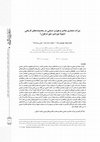
Journal of Studies on Iranian-Islamic City, 2016
Industrial heritage as a relatively recent phenomenon is the production of mid-20th century. The ... more Industrial heritage as a relatively recent phenomenon is the production of mid-20th century. The industrial heritage represents the culture, historical situation, processes, technologies and outstanding achievements of each region. Based on the value of contemporary architecture, It is necessary to protect them. Nowadays, the protection of industrial heritage has become an international challenge. One of the prerequisites of the protection of industrial heritage is recognizing
their value and their position. Proper protection of industrial heritage needs to study and deep understanding it in a large- scale and recognition of the value of the heritage for conservation process, in a regional scale. However, these kind of buildings, due to the large-scale,
locating in the proper point of the city, flexible plans (due to the modular structure) etc. have a great ability to transform into various functions, specially public and urban services. One of the most important values that can be imagined for industrial heritage, is architectural identity
of the region. Therefore, it is necessary to understand the effect of this types of structures through survey survey.
The aim of this paper is to evaluate the effectiveness of the industrial heritage on architectural identity in historic cities. The case study was selected by purpose - Dezful & “The MAKINEH of Flour” of Dezful, which now has become the mainstream of bazaar. The variable which is used
in order to define local identity, is using this element in address, which the residents giving to someone else to mention the accurate location of specific place, near the “MAKINEH”. The statistical population are selected from among people who lives in eastern sahrabedar mahallah.
The results of the paper shows that the industrial heritage has the value of architectural and urban identity in local level. The results indicate significance of comprehensive approach toward reunderstanding and redevelopment of contemporary buildings and industrial heritage
sites.
TICCIH Bulletin, 2018
Cave del Predil (Raibl in German and Rabelj in Slovene) is a small, isolated mountain village in ... more Cave del Predil (Raibl in German and Rabelj in Slovene) is a small, isolated mountain village in northeastern Italy, located at at 990 m on a strategic crossroads near the borders of Austria and Slovenia, where the Slavic, Germanic, and Alpine cultures have collided and blended over the centuries. The settlement, one of a kind for the Friuli Venezia Giulia region, has received funding for its enhancement and preservation, as well as important safety measures. But these have not solved the difficult problem of the elevated environmental impact of such and abandoned industrial site.
Books by Hassan Bazazzadeh
The Heritage of the Oil Industry, 2020
articles by Hassan Bazazzadeh
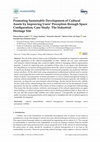
Sustainability- MDPI, 2020
The role of the cultural assets as one of the pillars of sustainable development is undeniably of... more The role of the cultural assets as one of the pillars of sustainable development is undeniably of great significance in the cultural sustainability of cities. Indeed, the way users understand and interpret cultural heritage sites would be highly critical to managing cultural organizations properly. It means by improving users' perception of these sites, it can expect a fair distribution of comprehensive awareness among generations about the values of cultural assets. Past studies in spatial psychology have demonstrated that environmental properties can positively Influence human emotions. On the other hand, using computational-mathematical methods used to examine spatio-visual properties have rarely been compared to human perceptions. This paper examines the impact of spatio-visual properties on human perception as a clever cultural management strategy to promote cultural sustainability. It is discussed how environmental features in general, and visibility in particular, can shape the way users interpret cultural heritage. Results indicate that not only visibility of users' paths within cultural heritage sites can be an influential factor for the development of users' perception, but also the visibility of the entrance of these complexes can change their understanding. This means that decision-makers, architects, and managers of the cultural organizations can apply these findings as cultural management framework by defining predefined paths in these sites in the way that they possess high visibility and visible entrance. Consequently, the distribution of public awareness among generations can be improved to strengthen the role of cultural aspects in sustainable development.
Call for Papers (CFPs) by Hassan Bazazzadeh
New Metropolitan Perspectives (NMP 2022), 2022
We will chair a thematic session (TS 16) titled "POST-PANDEMIC SUSTAINABLE DEVELOPMENT & ADAPTIVE... more We will chair a thematic session (TS 16) titled "POST-PANDEMIC SUSTAINABLE DEVELOPMENT & ADAPTIVE REUSE PRACTICES OF INDUSTRIAL HERITAGE" at the NMP - New Metropolitan Perspectives 2022" International Symposium" (May 25th-27th, 2022), promoted by the LaborEst, PAU Department, Università Mediterranea of Reggio Calabria, Italy.











Uploads
Papers by Hassan Bazazzadeh
response, this paper aimed to investigate the impact of climate change on the heating and cooling energy demands of buildings as influential variables in building energy consumption in the city of Poznan, Poland. In this sense, through the statistical downscaling method and considering the most recent Typical Meteorological Year (2004–2018) as the baseline, the future weather data for 2050 and 2080 of the city of Poznan were produced according to the HadCM3 and A2 GHG scenario. These generated files were then used to simulate the energy demands in 16 building prototypes of the ASHRAE 90.1 standard. The results indicate an average increase in cooling load and a decrease in heating load at 135% and 40%, respectively, by 2080. Due to the higher share of heating load, the total thermal load of the buildings decreased within the study period. Therefore, while the total thermal load is currently under the decrease, to avoid its rise in the future, serious measures should be taken to control the increased cooling demand and, consequently, thermal load and GHG emissions.
their value and their position. Proper protection of industrial heritage needs to study and deep understanding it in a large- scale and recognition of the value of the heritage for conservation process, in a regional scale. However, these kind of buildings, due to the large-scale,
locating in the proper point of the city, flexible plans (due to the modular structure) etc. have a great ability to transform into various functions, specially public and urban services. One of the most important values that can be imagined for industrial heritage, is architectural identity
of the region. Therefore, it is necessary to understand the effect of this types of structures through survey survey.
The aim of this paper is to evaluate the effectiveness of the industrial heritage on architectural identity in historic cities. The case study was selected by purpose - Dezful & “The MAKINEH of Flour” of Dezful, which now has become the mainstream of bazaar. The variable which is used
in order to define local identity, is using this element in address, which the residents giving to someone else to mention the accurate location of specific place, near the “MAKINEH”. The statistical population are selected from among people who lives in eastern sahrabedar mahallah.
The results of the paper shows that the industrial heritage has the value of architectural and urban identity in local level. The results indicate significance of comprehensive approach toward reunderstanding and redevelopment of contemporary buildings and industrial heritage
sites.
Books by Hassan Bazazzadeh
articles by Hassan Bazazzadeh
Call for Papers (CFPs) by Hassan Bazazzadeh
response, this paper aimed to investigate the impact of climate change on the heating and cooling energy demands of buildings as influential variables in building energy consumption in the city of Poznan, Poland. In this sense, through the statistical downscaling method and considering the most recent Typical Meteorological Year (2004–2018) as the baseline, the future weather data for 2050 and 2080 of the city of Poznan were produced according to the HadCM3 and A2 GHG scenario. These generated files were then used to simulate the energy demands in 16 building prototypes of the ASHRAE 90.1 standard. The results indicate an average increase in cooling load and a decrease in heating load at 135% and 40%, respectively, by 2080. Due to the higher share of heating load, the total thermal load of the buildings decreased within the study period. Therefore, while the total thermal load is currently under the decrease, to avoid its rise in the future, serious measures should be taken to control the increased cooling demand and, consequently, thermal load and GHG emissions.
their value and their position. Proper protection of industrial heritage needs to study and deep understanding it in a large- scale and recognition of the value of the heritage for conservation process, in a regional scale. However, these kind of buildings, due to the large-scale,
locating in the proper point of the city, flexible plans (due to the modular structure) etc. have a great ability to transform into various functions, specially public and urban services. One of the most important values that can be imagined for industrial heritage, is architectural identity
of the region. Therefore, it is necessary to understand the effect of this types of structures through survey survey.
The aim of this paper is to evaluate the effectiveness of the industrial heritage on architectural identity in historic cities. The case study was selected by purpose - Dezful & “The MAKINEH of Flour” of Dezful, which now has become the mainstream of bazaar. The variable which is used
in order to define local identity, is using this element in address, which the residents giving to someone else to mention the accurate location of specific place, near the “MAKINEH”. The statistical population are selected from among people who lives in eastern sahrabedar mahallah.
The results of the paper shows that the industrial heritage has the value of architectural and urban identity in local level. The results indicate significance of comprehensive approach toward reunderstanding and redevelopment of contemporary buildings and industrial heritage
sites.